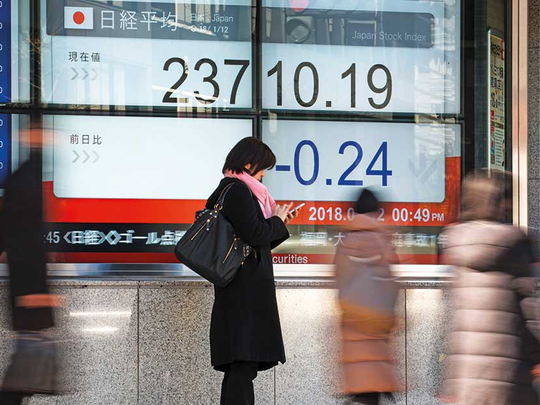
Dubai
Equities have been in a multi-year bull run. The Dow Jones Industrial Average reached new highs and hit its peak of more than 25,000, after gaining more than 30 per cent last year.
The Nasdaq Composite Index struck a lifetime high of more than 7,000. Elsewhere in Japan, the Topix index climbed to a 26-year high. The question on everyone’s mind now is whether the best behind us in equities.
Experts feel that equities may continue to do well as long as market fundamentals remain intact, but the upside may be limited.
“With global equity valuations now in line with 30-year averages, we don’t expect the same pace, or consistency, of gains as last year. But we believe investors can still expect positive returns,” said Mark Haefele, Global Chief Investment Officer at UBS.
This comes against the backdrop of a positive outlook on global economic growth, which is feeding into good corporate earnings. This, along with the US tax cut, is also expected to boost profits for companies. UBS expects the S&P 500 earnings per share to rise by 15 per cent in 2018 to $151.
Global GDP growth is expected to reach 3.9 pe recent in 2018 compared to 3.8 per cent in 2017, according to UBS. The other economic indicators are also strong. The Eurozone manufacturing PMI rose to 60.6 in December, its strongest level since the survey began in mid-1997. In the US, the ISM manufacturing index rose to 59.7 from November’s 58.2.
“The important thing is how corporations translate the good economic backdrop into earnings. Earnings until 2016 have been the pinpoint. We have seen a change in earnings since 2016 and there is no earnings’ stagnation anymore. The earnings growth may continue,” Nannette Hechler-Fayd’herbe, Managing Director of International Wealth Management Division at Credit Suisse, told Gulf News.
Credit Suisse is cautious on US equities due to higher valuations, but is more bullish on European and Japanese equities.
“The US is seen to have historical high valuations at a time when interest rates are lower than what they are on an average. So it is normal that these valuations will remain more elevated than in the past. Even with these type of valuations, we have a positive view of the US economy and US corporations. US tax may act as an additional boost. The US markets may be vulnerable to any temporary setback and regionally we will put our preference in those markets, which have slightly more attractive valuations, for example — Europe or Japan,” Hechler-Fayd’herbe said.
Barclays has an overweight allocation on emerging markets equities as the business cycle continues to firm up, as evidenced by business confidence surveys and trade data.
Preferred region
In its compass report, Barclays highlights short term tactical adjustments recognising investment opportunities emerging from shorter-term cyclical views from across asset classes and markets across the world.
“The first compass report for 2018 outlines the main themes dominating investment portfolios as we look to the year ahead, where we expect stocks and equities to continue outperforming bonds in the economic cycle. Currently, no key indicators signal a major change to this outlook,” Francesco Grosoli, Barclays’ Head of Private Bank for Europe, the Middle East and Africa (EMEA), said.
Asian markets remain as the preferred region for Barclays, with Korea, Taiwan and China (offshore) showing the highest conviction country bets on a strategic basis. Barclays also has an overweight on high yield and emerging markets bonds.
Barclays is underweight on allocation to cash and short-maturity bonds, developed government bonds, alternative trading strategies and investment grade bonds. They also kept a neutral view to investments into commodities and real estate.
“ ... Investments are best served in diversified long-term core portfolios with a strategic mix of assets, using professional investors providing active management on top of this allocation to achieve strong long-term returns,” Grosoli said.












